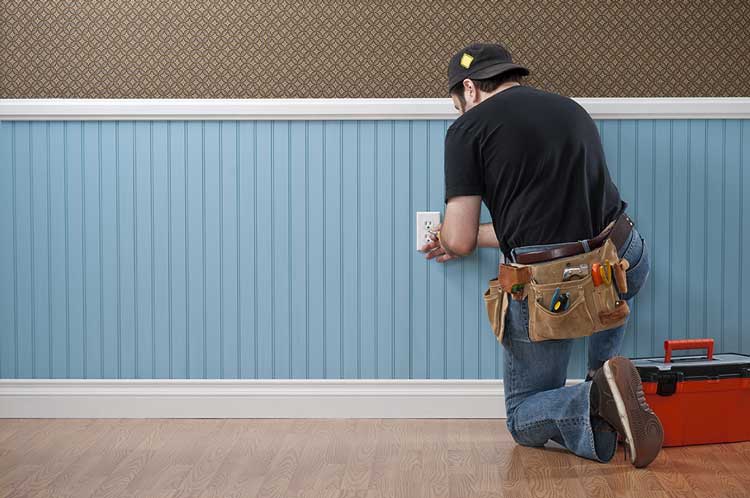Last updated May 2025

Anyone who has been zapped by a poorly installed light fixture (or trapped by a busted garage door opener) realizes electricity problems are shockingly annoying. Fixing them—or installing new outlets, chandeliers, and the like—requires know-how and safe practices. That’s why, for most people, hiring an electrician is the brightest idea for home repairs and improvements involving power and plugs. Here, we illuminate you on how to find an electrician who sparks joy at a good price.
Review Our Ratings
Although some outfits received dim ratings from many customers, we’ve also found several great contractors. Our Ratings Tables report ratings we collected when we surveyed Consumers’ Checkbook subscribers plus a sample of other area homeowners we invited to participate. Our Ratings Tables report results for companies that received 10 or more ratings on our surveys.
The Ratings Tables report the percentage of each company’s surveyed customers who rated it “superior” (as opposed to “adequate” or “inferior”) on several questions: “overall quality,” “doing work properly,” “promptness,” “letting you know cost early,” and “advice on service options and costs.” As you can see, scores vary greatly from company to company. Click here for further discussion of our customer survey and other research methods.
Check Insurance and Licensing
Before hiring an electrician, ask them to provide proof of licensure and make sure they have up-to-date policies for liability and workers’ compensation coverage. By choosing a licensed contractor, you can use the threat of license cancellation as one form of leverage to resolve a dispute.
Check for Complaints
Our Ratings Tables also show counts of complaints we gathered from the Better Business Bureau (BBB) for a recent three-year period and complaint rates relative to the volume of work companies do.
Don’t Get Shocked by High Prices
To compare companies’ rates, our undercover shoppers called local companies and requested price quotes for four installation jobs. The figure below reports the range of prices we got for each job; some companies quoted costs more than twice as high as others for the same work.
We used those prices to calculate a price comparison score for each company, shown on our Ratings Tables. The scores, which are adjusted so that the average for all companies equals $100, tell you how each company’s quotes, on average, compare to the average price for all companies quoting on the same jobs. Thus, a score of $110 means a company’s quotes average 10 percent above the all-company average. The price comparison scores can steer you to good candidates for reasonably priced installation work. But don’t rule out companies with relatively high price comparison scores. In many cases, companies with high prices on some jobs have low prices on others.
You don’t have to pay more to get good service. The companies listed on our Ratings Tables that receive our top rating for quality were actually more likely to charge low prices than the companies with lower ratings.
The key to getting a good price is to obtain several bids. For simple jobs, you can secure quotes by phone or email. For more complex ones, an estimator will usually visit your home. Time invested getting at least two or three bids usually pays off, especially for large jobs. The second bid may be higher than the first, but it will often be lower.
Fixed-price bids are best, but for most smaller jobs and installations you’ll have to pay on a time-and-materials basis.
For an idea of which pros might be the least expensive for time-and-materials jobs, our Ratings Tables indicate each company’s hourly labor rate and minimum charge for service calls. Keep in mind that hourly labor rates don’t reflect differences in charges for parts and materials, and don’t account for the speed at which different companies work.
When comparing hourly labor rates and minimum charges, check several details:
- Does the company impose a minimum charge for service calls? If so, how much? How much time does it cover? Is travel time charged against this minimum? While most companies charge all customers the same minimum service fee regardless of where they live, it’s a point worth checking.
- How does the company divide its billing time (for example, quarter hours or half hours)?
- How much does the company charge per time unit?
- How does the company handle fractions of time units? (For example, does it round to the nearest half hour—either up or down—or always round up?)
- How many electricians does the rate cover?
- Does the company ever charge for a service call based on a flat rate rather than actual hours?

Avoid Common Problems
If possible, before work begins get a written fixed-price quote, rather than an estimate based on material costs plus an hourly rate. A fixed price will protect you against a surprisingly high bill.
Make sure the proposal specifies:
- Makes and model numbers of all supplied fixtures.
- Where new wiring will run.
- Who cuts holes in the wall, patches the holes, and repaints over the patches. If this type of work isn’t covered in the proposal, it won’t get done.
- If permits are required, note that the company will secure them.
- When work is to begin and how long it will take.
- Negotiate for the best possible warranty—at minimum one year.
- For large jobs, try to withhold as much payment as possible until all work is completed. This gives you leverage to prod the company to redo the job correctly if you are dissatisfied. Such a payment arrangement also cushions the blow if the company abandons your job.
- If possible, pay by credit card. If you are dissatisfied, you can dispute the charge.


